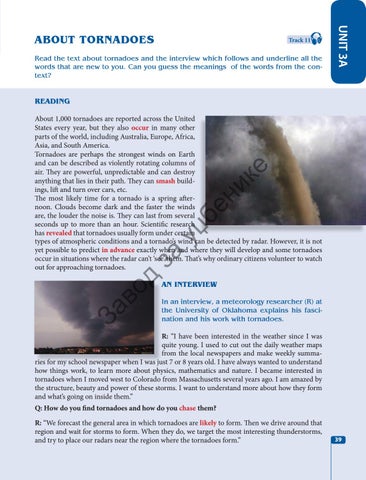Track 11
Read the text about tornadoes and the interview which follows and underline all the words that are new to you. Can you guess the meanings of the words from the context?
UNIT 3A
ABOUT TORNADOES
READING
За
во
д
за
уџ бе
ни ке
About 1,000 tornadoes are reported across the United States every year, but they also occur in many other parts of the world, including Australia, Europe, Africa, Asia, and South America. Tornadoes are perhaps the strongest winds on Earth and can be described as violently rotating columns of air. They are powerful, unpredictable and can destroy anything that lies in their path. They can smash buildings, lift and turn over cars, etc. The most likely time for a tornado is a spring afternoon. Clouds become dark and the faster the winds are, the louder the noise is. They can last from several seconds up to more than an hour. Scientific research has revealed that tornadoes usually form under certain types of atmospheric conditions and a tornado’s wind can be detected by radar. However, it is not yet possible to predict in advance exactly when and where they will develop and some tornadoes occur in situations where the radar can’t ‘see’ them. That’s why ordinary citizens volunteer to watch out for approaching tornadoes. AN INTERVIEW In an interview, a meteorology researcher (R) at the University of Oklahoma explains his fascination and his work with tornadoes.
R: “I have been interested in the weather since I was quite young. I used to cut out the daily weather maps from the local newspapers and make weekly summaries for my school newspaper when I was just 7 or 8 years old. I have always wanted to understand how things work, to learn more about physics, mathematics and nature. I became interested in tornadoes when I moved west to Colorado from Massachusetts several years ago. I am amazed by the structure, beauty and power of these storms. I want to understand more about how they form and what’s going on inside them.” Q: How do you find tornadoes and how do you chase them? R: “We forecast the general area in which tornadoes are likely to form. Then we drive around that region and wait for storms to form. When they do, we target the most interesting thunderstorms, and try to place our radars near the region where the tornadoes form.”
39







































